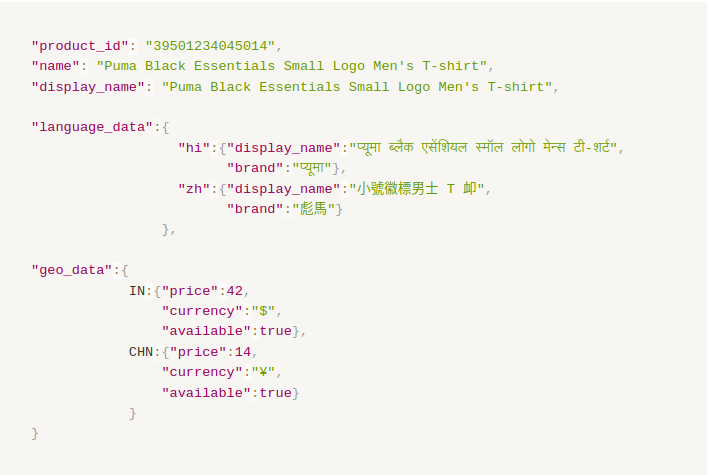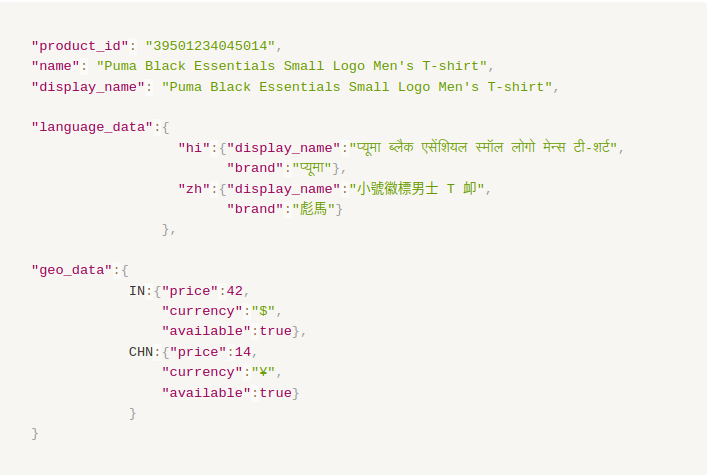Guide on Catalog Localization
- Getting Started
- Bot Building
- Smart Agent Chat
- Conversation Design
-
Developer Guides
Code Step Integration Static Step Integration Shopify Integration SETU Integration Exotel Integration CIBIL integration Freshdesk KMS Integration PayU Integration Zendesk Guide Integration Twilio Integration Razorpay Integration LeadSquared Integration USU(Unymira) Integration Helo(VivaConnect) Integration Salesforce KMS Integration Stripe Integration PayPal Integration CleverTap Integration Fynd Integration HubSpot Integration Magento Integration WooCommerce Integration Microsoft Dynamics 365 Integration
- Deployment
- External Agent Tool Setup
- Analytics & Reporting
- Notifications
- Commerce Plus
- Troubleshooting Guides
- Release Notes
Overview
Increasingly, ecommerce brands are selling to customers across different geographies to cater to a global customer base. However, the location of a user is a major influencer of purchase behavior, stemming from differences in spoken language, culture, purchasing power, and brand awareness.
Localization plays a very important role in helping brands be more relatable for their global customer base, build trust, and successfully drive up purchases. To succeed in global markets, brands must be able to deliver a localized buying experience to their shoppers.
This requires showing product prices in local currencies, displaying product information in the user’s vernacular, and setting localized product inventory.
Commerce Plus helps brands provide localized buying experiences to engage with shoppers throughout their buying journeys across messaging channels to deliver a superior experience, and drive up purchases as well as retention.
Important Pointers
Your Haptik IVA will not display products in the following scenarios:
- The Product ID is not present in your Primary Catalog.
- A mandatory data field (for a language or country) is missing.
- All information (specific to a language or location) will be supplied “as is”. Haptik does not translate or process any data shared using our API endpoints.
- Clients are responsible for necessary backend checks related to price fields, to handle inclusion of taxes, shipping charges, forex charges, etc.
- We currently do not support localization of Product Reviews Analysis. If you wish to request for this feature, please reach out to your Customer Success Manager.
Prerequisites
- Client readiness with relevant product information in different languages.
- Client readiness with relevant localized product information for all specified locations.
- Integration with the Haptik Platform as per our API schema for all relevant skills.
- Configuration of a Commerce Plus IVA with the required skills.
Steps to Activate the Localization Feature for Your IVA
Brands that maintain localized catalogs can use Commerce Plus’ APIs to share localized product information with Haptik. Localized product data can be broadly bucketed into:
- Product data in different languages
- Product data for different geographies
In order to set up localization, it is necessary to share a “Primary Catalog” in English, and activate the localization feature for your IVA.
1. Product data in different languages
Haptik supports the display of product catalog data in multiple languages. In order to do so, Brands have to supply the required data (specified below) for all relevant products as part of their catalog data feed.
- The relevant language code using the “language_data” key for each relevant product.
- The following (mandatory) product information in the local language script:
- display_name
- Brand
- Description
- Return_policy (If applicable)
- Offers (If applicable)
- country_of_origin (If applicable)
-
Configure the “Language Selection” skill on your IVA to ensure that end-users are able to select their preferred language before starting a conversation.
- Account for all relevant languages in this skill.
- Inform your end-users during the chat journey about available languages.
Review relevant bot responses to ensure that they are appropriately translated / transliterated in terms of their grammar, tone, meaning, and colloquialisms.
As a final step, select a default language to be used when a user does not specify a language preference.
With the aforementioned steps, your IVA will be successfully configured to engage with users in the specified languages.
Example:
2. Product data for different geographies
Haptik supports brands to display product content localized for a given geography. This can be done at 2 levels:
- Country
- ZIP/PIN Code (inventory only)
In order to set this up, brands have to supply the following information for relevant products:
- Localized data, which includes:
- Country Code in the “geo_data” key.
- (for PIN/ZIP Code level localization only) PIN / ZIP Code mapping as per our “pincode-specific-update” API endpoint (documentation).
- Currency code as the “currency” key for setting denominations for prices.
-
The following mandatory product information with respect to each region:
- mrp
- price
- available
- return_policy (if applicable)
- store_rank (if applicable)
- offers* (if applicable)
- url (if applicable)
Textual product fields in geo_data must also be supplied in all applicable languages (if relevant).
-
Configure the “Location Selection” skill on your IVA to help end-users confirm their location if required.
- Ensure that your IVA provides all relevant location options.
- Educate your users if they need to share their location to avail your services.
-
Set your serviceability policy to determine whether users outside your list of locations can engage with your IVA:
- Restricted: if a user is not located in a serviceable location, the IVA will prompt the user to choose a different location to proceed (or discontinue their chat).
- Open: if a user is not located in a serviceable location, the IVA will display product information as per the default location specified by you.
- As a final step, select a location that will serve as the default in cases where a user does not confirm their location, or their location data is unavailable.
With the aforementioned steps, your IVA will be successfully configured to display localized product information to your users.
Example
List of Language & Country Codes
1. List of country codes
We use the ISO 3166 international standard – Alpha 2 codes. Please refer to “List of country codes by alpha-2, alpha-3 code (ISO 3166)”.
2. List of currency codes
We use the ISO 4217 international standard – Alpha 2 codes. Please refer to “ISO 4217 — Currency codes”.
Kindly get in touch with your Haptik SPOC to know about our API schema.


